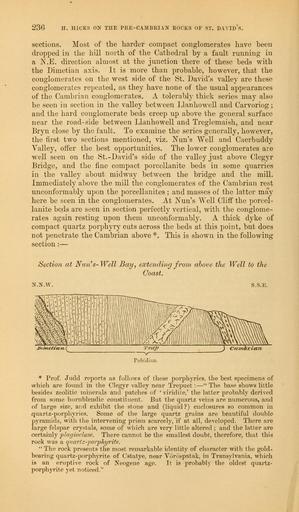MAKE A MEME
View Large Image

| View Original: | The_Quarterly_journal_of_the_Geological_Society_of_London_(12736297414).jpg (1866x3200) | |||
| Download: | Original | Medium | Small | Thumb |
| Courtesy of: | commons.wikimedia.org | More Like This | ||
| Keywords: The Quarterly journal of the Geological Society of London (12736297414).jpg 236 <br> H HICKS ON THE PRE-CAMBRIAN ROCKS OF ST DAVID S <br> sections Most of the harder compact conglomerates have been <br> dropped in the hill north of the Cathedral by a fault running in <br> a N E direction almost at the junction there of these beds with <br> the Dimetian axis It is more than probable however that the <br> conglomerates on the west side of the St David's valley are these <br> conglomerates repeated as they have none of the usual appearances <br> of the Cambrian conglomerates A tolerably thick series may also <br> be seen in section in the valley between Llanhowcll and Carvoriog ; <br> and the hard conglomerate beds creep up above the general surface <br> near the road-side between Llanhowell and Treglemaish and near <br> Bryn close by the fault To examine the series generally however <br> the first two sections mentioned viz Nun's Well and Caerbuddy <br> Valley offer the best opportunities The lower conglomerates are <br> well seen on the St -David's side of the valley just above Clegyr <br> Bridge and the fine compact porcellanite beds in some quarries <br> in the valley about midway between the bridge and the mill <br> Immediately above the mill the conglomerates of the Cambrian rest <br> unconformably upon the porcellanites ; and masses of the latter may <br> here be seen in the conglomerates At Nun's Well Cliff the porcel- <br> lanite beds are seen in section perfectly vertical with the conglome- <br> rates again resting upon them unconformably A thick dyke of <br> compact quartz porphyry cuts across the beds at this point but does <br> not penetrate the Cambrian above This is shown in the following- <br> section ” <br> Section at Nun's- Well Bay extending from above the Well to the <br> Coast <br> N N W <br> S S E <br> X i'metlu -n <br> TfO/J <br> v <br> Pebidinn <br> Cumbxlan <br> Prof Judd reports as follows of these porphyries the best specimens of <br> which are found in the Clegyr valley near Trepuet ” The base shows little <br> besides zeolitic minerals and patches of ' viridite ' the latter probably derived <br> from some hornblendic constituent But the quartz veins are numerous and <br> of large size ar d exhibit the stone and liquid enclosures so common in <br> quartz-porphyries Some of the large quartz grains are beautiful double <br> pyramids with the intervening prism scarcely if at all developed There are <br> large felspar crystals some of which are very little altered ; and the latter are <br> certainly plagioclase There cannot be the smallest doubt therefore that this <br> rock was a quartz- forphy rite <br> The rock presents the most remarkable identity of character with the gold- <br> bearing quai-tz-porphyrite of Cstatye near Vorospatak in Transylvania which <br> is an eruptive rock of Neogene age It is probably the oldest quartz- <br> porphyrite yet noticed 35818355 110705 51125 Page 236 Text 33 http //www biodiversitylibrary org/page/35818355 1877 Geological Society of London Biodiversity Heritage Library The Quarterly journal of the Geological Society of London v 33 1877 Geology Periodicals Smithsonian Libraries bhl page 35818355 dc identifier http //biodiversitylibrary org/page/35818355 smithsonian libraries Information field Flickr posted date ISOdate 2014-02-24 Check categories 2015 August 26 CC-BY-2 0 BioDivLibrary https //flickr com/photos/61021753 N02/12736297414 2015-08-26 20 04 46 cc-by-2 0 PD-old-70-1923 The Quarterly journal of the Geological Society of London 1877 Photos uploaded from Flickr by Fæ using a script | ||||